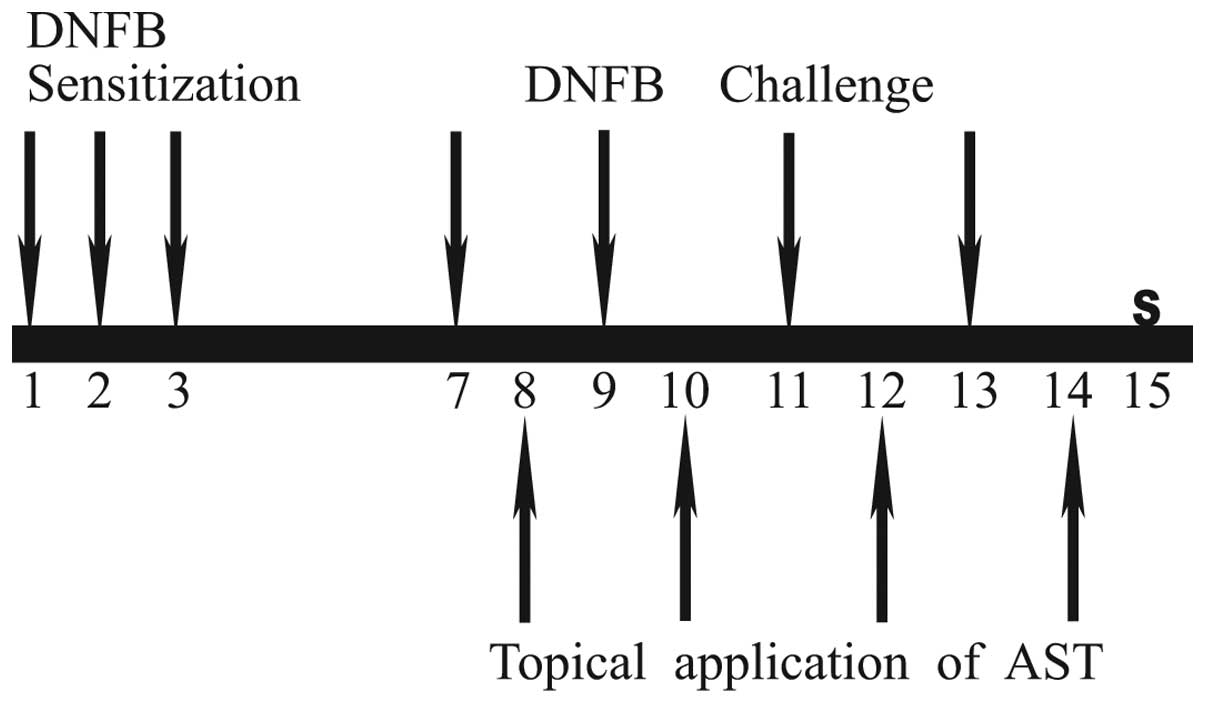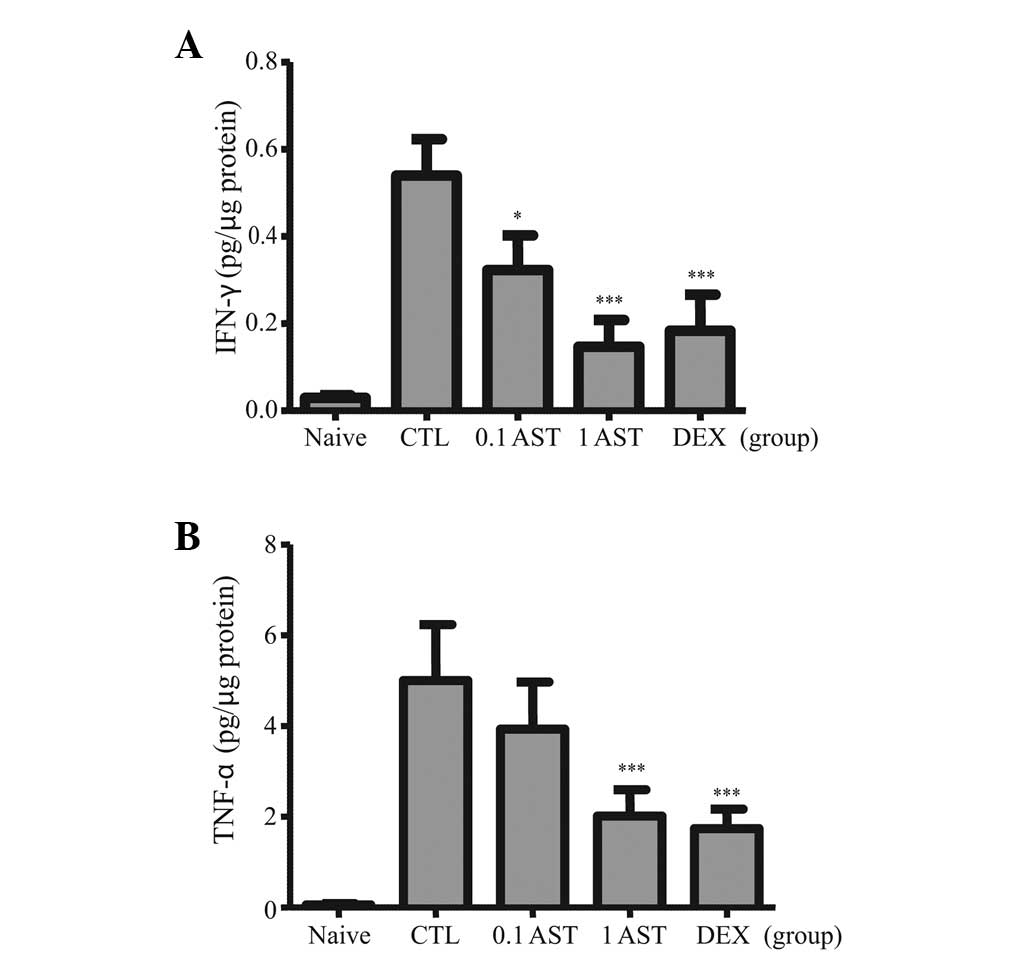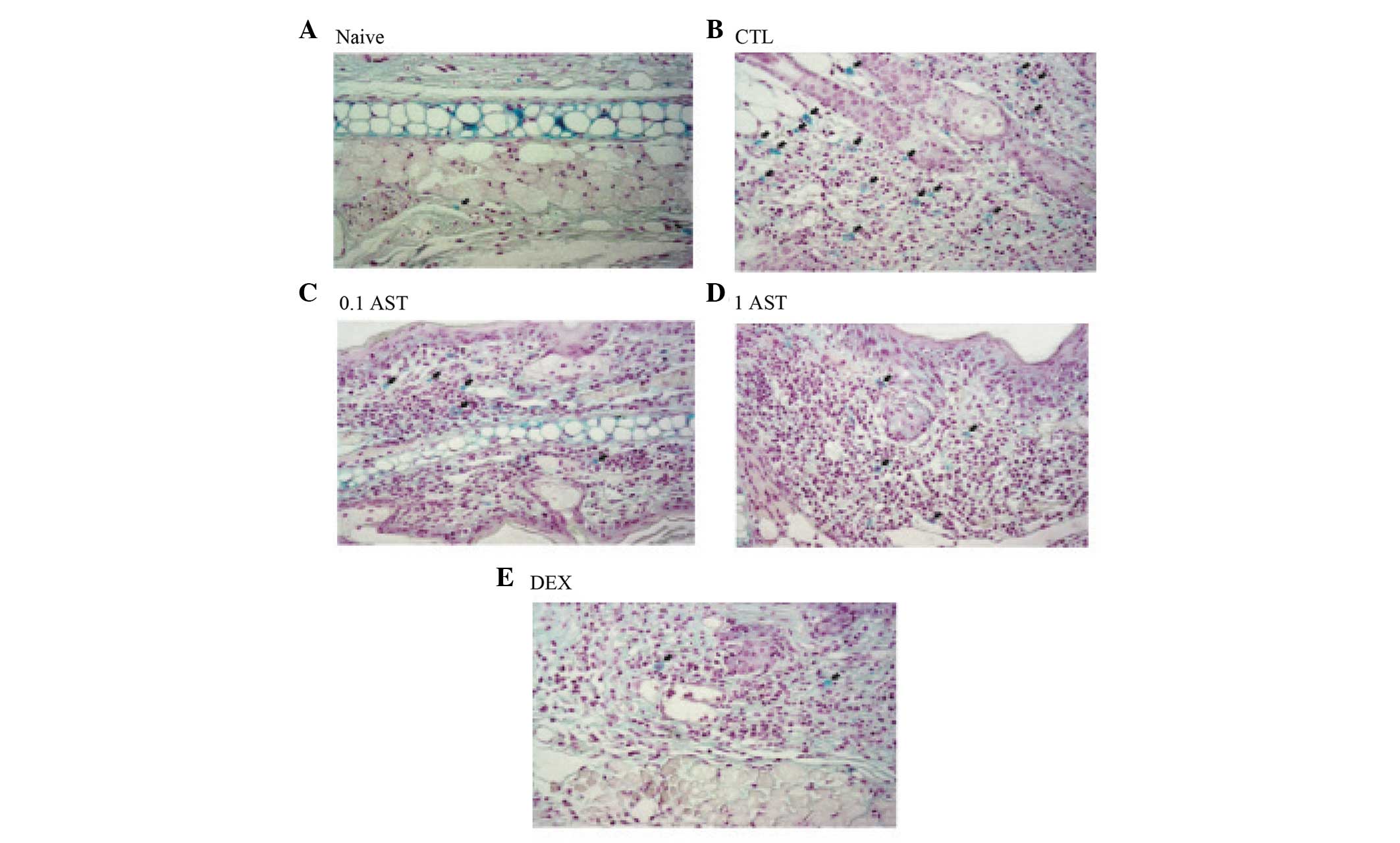|
1
|
Saint-Mezard P, Rosieres A, Krasteva M, et
al: Allergic contact dermatitis. Eur J Dermatol. 14:284–295.
2004.PubMed/NCBI
|
|
2
|
Cavani A and De Luca A: Allergic contact
dermatitis: novel mechanisms and therapeutic perspectives. Curr
Drug Metab. 11:228–233. 2010. View Article : Google Scholar : PubMed/NCBI
|
|
3
|
Kapsenberg ML, Wierenga EA, Stiekema FE,
Tiggelman AM and Bos JD: Th1 lymphokine production profiles of
nickel-specific CD4+ T-lymphocyte clones from nickel contact
allergic and non-allergic individuals. J Invest Dermatol. 98:59–63.
1992. View Article : Google Scholar : PubMed/NCBI
|
|
4
|
Shimada Y, Hasegawa M, Kaburagi Y, et al:
Lselectin or ICAM-1 deficiency reduces an immediate-type
hypersensitivity response by preventing mast cell recruitment in
repeated elicitation of contact hypersensitivity. J Immunol.
170:4325–4334. 2003. View Article : Google Scholar : PubMed/NCBI
|
|
5
|
Natsuaki M, Yano N, Yamaya K and Kitano Y:
Immediate contact hypersensitivity induced by repeated hapten
challenge in mice. Contact Dermatitis. 43:267–272. 2000. View Article : Google Scholar : PubMed/NCBI
|
|
6
|
Askenase P, Van Loveren H, Kraeuter-Kops
S, et al: Defective elicitation of delayed-type hypersensitivity in
W/Wv and SI/SId mast cell-deficient mice. J Immunol. 131:2687–2694.
1983.PubMed/NCBI
|
|
7
|
Dudeck A, Dudeck J, Scholten J, et al:
Mast cells are key promoters of contact allergy that mediate the
adjuvant effects of haptens. Immunity. 34:973–84. 2011. View Article : Google Scholar : PubMed/NCBI
|
|
8
|
Theoharides TC, Alysandratos KD, Angelidou
A, et al: Mast cells and inflammation. Biochim Biophys Acta.
1822:21–33. 2012. View Article : Google Scholar :
|
|
9
|
Broide DH: Molecular and cellular
mechanisms of allergic disease. J Allergy Clin Immunol.
108:S65–S71. 2001. View Article : Google Scholar : PubMed/NCBI
|
|
10
|
Fuchs J, Zollner TM, Kaufmann R and Podda
M: Redox-modulated pathways in inflammatory skin diseases. Free
Radic Biol Med. 30:337–353. 2001. View Article : Google Scholar : PubMed/NCBI
|
|
11
|
Sharkey P, Eedy DJ, Burrows D, McCaigue MD
and Bell AL: A possible role for superoxide production in the
pathogenesis of contact dermatitis. Acta Derm Venereol. 71:156–159.
1991.PubMed/NCBI
|
|
12
|
Finnen MJ, Lawrence CM and Shuster S:
Inhibition of dithranol inflammation by free radical scavengers.
Lancet. 217:1129–1130. 1984. View Article : Google Scholar
|
|
13
|
Senaldi G, Pointaire P, Piguet PF and Grau
GE: Protective effect of N-acetylcysteine in hapten-induced
irritant and contact hypersensitivity reactions. J Invest Dermatol.
102:934–937. 1994. View Article : Google Scholar : PubMed/NCBI
|
|
14
|
Sur R, Nigam A, Grote D, Liebel F and
Southall MD: Avenanthramides, polyphenols from oats, exhibit
anti-inflammatory and anti-itch activity. Arch Dermatol Res.
300:569–574. 2008. View Article : Google Scholar : PubMed/NCBI
|
|
15
|
Sakai S, Sugawara T and Hirata T:
Inhibitory effect of dietary carotenoids on
dinitrofluorobenzene-induced contact hypersensitivity in mice.
Biosci Biotechnol Biochem. 75:1013–1015. 2011. View Article : Google Scholar : PubMed/NCBI
|
|
16
|
Fassett RG and Coombes JS: Astaxanthin: a
potential therapeutic agent in cardiovascular disease. Mar Drugs.
9:447–465. 2011. View Article : Google Scholar : PubMed/NCBI
|
|
17
|
Campoio TR, Oliveira FA and Otton R:
Oxidative stress in human lymphocytes treated with fatty acid
mixture: role of carotenoid astaxanthin. Toxicol In Vitro.
25:1448–1456. 2011. View Article : Google Scholar : PubMed/NCBI
|
|
18
|
Yasui Y, Hosokawa M, Mikami N, Miyashita K
and Tanaka T: Dietary astaxanthin inhibits colitis and
colitis-associated colon carcinogenesis in mice via modulation of
the inflammatory cytokines. Chem Biol Interact. 193:79–87. 2011.
View Article : Google Scholar : PubMed/NCBI
|
|
19
|
Suzuki Y, Ohgami K, Shiratori K, et al:
Suppressive effects of astaxanthin against rat endotoxin-induced
uveitis by inhibiting the NF-kappaB signaling pathway. Exp Eye Res.
82:275–281. 2006. View Article : Google Scholar
|
|
20
|
Izumi-Nagai K, Nagai N, Ohgami K, et al:
Inhibition of choroidal neovascularization with an
anti-inflammatory carotenoid astaxanthin. Invest Ophthalmol Vis
Sci. 49:1679–1685. 2008. View Article : Google Scholar : PubMed/NCBI
|
|
21
|
Starr RC and Zeikus JA: UTEX - The culture
collection of algae at the University of Texas at Austin. J Phycol.
29(Suppl): 1–106. 1993. View Article : Google Scholar
|
|
22
|
Kwak TW, Cha JY, Lee CW, Kim YM, Yoo BH,
Kim SG, Kim JM, Park SH and An WG: Anti-inflammatory and
antioxidant effect of astaxanthin derived from microalgae. J Life
Sci. 21:1377–1384. 2011.In Korean. View Article : Google Scholar
|
|
23
|
Matsuda H, Morikawa T, Managi H and
Yoshikawa M: Antiallergic principles from Alpinia galanga:
Structural requirements of phenylpropanoids for inhibition of
degranulation and release of TNF-alpha and IL-4 in RBL-2H3 cells.
Bioorg Med Chem Lett. 13:3197–3202. 2003. View Article : Google Scholar : PubMed/NCBI
|
|
24
|
Bickers DR and Athar M: Oxidative stress
in the pathogenesis of skin disease. J Invest Dermatol.
126:2565–2575. 2006. View Article : Google Scholar : PubMed/NCBI
|
|
25
|
Guerin M, Huntley ME and Olaizola M:
Haematococcus astaxanthin: applications for human health and
nutrition. Trends Biotechnol. 21:210–216. 2003. View Article : Google Scholar : PubMed/NCBI
|
|
26
|
Lorenz RT and Cysewski GR: Commercial
potential for Haematococcus microalgae as a natural source of
astaxanthin. Trends Biotechnol. 18:160–167. 2000. View Article : Google Scholar : PubMed/NCBI
|
|
27
|
Machado-Pinto J, McCalmont T and Golitz L:
Eosinophilic and neutrophilic spongiosis: clues to the diagnosis of
immunobullous diseases and other inflammatory disorders. Semin
Cutan Med Surg. 15:308–316. 1996. View Article : Google Scholar : PubMed/NCBI
|
|
28
|
Dearman RJ, Basketter DA and Kimber I:
Characterization of chemical allergens as a function of divergent
cytokine secretion profiles induced in mice. Toxicol Appl
Pharmacol. 138:308–316. 1996. View Article : Google Scholar : PubMed/NCBI
|
|
29
|
Kobayashi Y: The role of chemokines in
neutrophil biology. Front Biosci. 13:2400–2407. 2008. View Article : Google Scholar
|
|
30
|
Grabbe S and Schwarz T: Immunoregulatory
mechanisms involved in elicitation of allergic contact
hypersensitivity. Immunol Today. 19:37–44. 1998. View Article : Google Scholar : PubMed/NCBI
|
|
31
|
Gould HJ, Sutton BJ, Beavil AJ, et al: The
biology of IgE and the basis of allergic disease. Annu Rev Immunol.
21:579–628. 2003. View Article : Google Scholar
|
|
32
|
Navi D, Saegusa J and Liu FT: Mast cells
and immunological skin diseases. Clin Rev Allergy Immunol.
33:144–155. 2007. View Article : Google Scholar : PubMed/NCBI
|
|
33
|
Kanda N and Watanabe S: Histamine enhances
the production of granulocyte-macrophage colony-stimulating factor
via protein kinase Calpha and extracellular signal-regulated kinase
in human keratinocytes. J Invest Dermatol. 122:863–872. 2004.
View Article : Google Scholar : PubMed/NCBI
|
|
34
|
Jordana M, Befus A, Newhouse M,
Bienenstock J and Gauldie J: Effect of histamine on proliferation
of normal human adult lung fibroblasts. Thorax. 43:552–558. 1988.
View Article : Google Scholar : PubMed/NCBI
|
|
35
|
Biedermann T, Kneilling M, Mailhammer R,
et al: Mast cells control neutrophil recruitment during T
cell-mediated delayed-type hypersensitivity reactions through tumor
necrosis factor and macrophage inflammatory protein 2. J Exp Med.
192:1441–1452. 2000. View Article : Google Scholar : PubMed/NCBI
|















